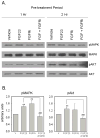Fibroblast growth factor 23 inhibits extrarenal synthesis of 1,25-dihydroxyvitamin D in human monocytes
- PMID: 22886720
- PMCID: PMC3511915
- DOI: 10.1002/jbmr.1740
Fibroblast growth factor 23 inhibits extrarenal synthesis of 1,25-dihydroxyvitamin D in human monocytes
Abstract
Vitamin D is a potent stimulator of monocyte innate immunity, and this effect is mediated via intracrine conversion of 25-hydroxyvitamin D (25OHD) to 1,25-dihydroxyvitamin D (1,25(OH)(2) D). In the kidney, synthesis of 1,25(OH)(2) D is suppressed by fibroblast growth factor 23 (FGF23), via transcriptional suppression of the vitamin D-activating enzyme 1α-hydroxylase (CYP27B1). We hypothesized that FGF23 also suppresses CYP27B1 in monocytes, with concomitant effects on intracrine responses to 1,25(OH)(2) D. Healthy donor peripheral blood mononuclear cell monocytes (PBMCm) and peritoneal dialysate monocyte (PDm) effluent from kidney disease patients were assessed at baseline to confirm the presence of mRNA for FGF23 receptors (FGFRs), with Klotho and FGFR1 being more strongly expressed than FGFR2/3/4 in both cell types. Immunohistochemistry showed coexpression of Klotho and FGFR1 in PBMCm and PDm, with this effect being enhanced following treatment with FGF23 in PBMCm but not PDm. Treatment with FGF23 activated mitogen-activated protein kinase (MAPK) and protein kinase B (Akt) pathways in PBMCm, demonstrating functional FGFR signaling in these cells. FGF23 treatment of PBMCm and PDm decreased expression of mRNA for CYP27B1. In PBMCm this was associated with downregulation of 25OHD to 1,25(OH)(2) D metabolism, and concomitant suppression of intracrine induced 24-hydroxylase (CYP24A1) and antibacterial cathelicidin (LL37). FGF23 suppression of CYP27B1 was particularly pronounced in PBMCm treated with interleukin-15 to stimulate synthesis of 1,25(OH)(2) D. These data indicate that FGF23 can inhibit extra-renal expression of CYP27B1 and subsequent intracrine responses to 1,25(OH)(2) D in two different human monocyte models. Elevated expression of FGF23 may therefore play a crucial role in defining immune responses to vitamin D and this, in turn, may be a key determinant of infection in patients with chronic kidney disease (CKD).
Copyright © 2013 American Society for Bone and Mineral Research.
Conflict of interest statement
All authors state that they have no conflicts of interest
Figures




References
-
- Liu S, Quarles LD. How fibroblast growth factor 23 works. J Am Soc Nephrol. 2007;18(6):1637–47. - PubMed
-
- Yamazaki Y, Tamada T, Kasai N, Urakawa I, Aono Y, Hasegawa H, Fujita T, Kuroki R, Yamashita T, Fukumoto S, Shimada T. Anti-FGF23 neutralizing antibodies show the physiological role and structural features of FGF23. J Bone Miner Res. 2008;23(9):1509–18. - PubMed
-
- Yoshiko Y, Wang H, Minamizaki T, Ijuin C, Yamamoto R, Suemune S, Kozai K, Tanne K, Aubin JE, Maeda N. Mineralized tissue cells are a principal source of FGF23. Bone. 2007;40(6):1565–73. - PubMed
-
- Shimada T, Hasegawa H, Yamazaki Y, Muto T, Hino R, Takeuchi Y, Fujita T, Nakahara K, Fukumoto S, Yamashita T. FGF-23 is a potent regulator of vitamin D metabolism and phosphate homeostasis. Journal of bone and mineral research: the official journal of the American Society for Bone and Mineral Research. 2004;19(3):429–35. - PubMed
Publication types
MeSH terms
Substances
Grants and funding
LinkOut - more resources
Full Text Sources
Medical
Miscellaneous

